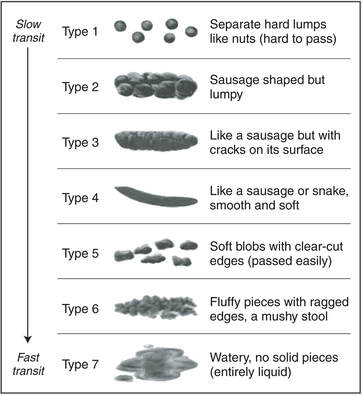 In this blog post, you are going to read about constipation, a problem that affects 20% of the population. You’re going to learn what it is, the few main reasons for it, and one thing you can definitely do about it. So let’s get down to business. What is constipation? Many think they are constipated if they don’t have a BM every day. However, having three BMs a week is actually considered normal! So what are the facts? According to a well-referenced criteria, you are clinically constipated if two or more of the following occur at least 25% of the time, for at least 3 months:
To check the consistency of your stool, here is a useful chart I show my patients. Types 1 and 2 are considered on the constipation side of things while types 5-7 are considered on the diarrhea side of things. Types 3 and 4 are normal. If you fit into the above criteria, your next question is probably…. Why is this happening to me? Why am I constipated? Here’s a general breakdown of some reasons you might be constipated.
What can I do about it? While I could write a book to address solutions for the full list above, I can address the easiest preventable cause for straining - toileting posture. Cavemen used to squat on the floor. Watch your dog next time he’s going. You’ll see that pup tuck his pelvis right under him, the normal way to go. But with the advent of Western toilet seats, we end up sitting with our hips barely flexed, which changes the positioning of our pelvic floor muscles. Now, for an analogy. When your hips are not bent enough, your stool passes through like a kid sliding down a twisty turny water slide. When you squat all the way down, your stool passes like a drop tower at a theme park… straight down, quick and easy! Tips:
Last Thoughts. Pooping problems can ultimately interfere with the quality of your life. It takes a bit of investigation to determine the root causes. Seeing a pelvic floor physical therapist can address many of the reasons listed above. For example, a pelvic floor physical therapist can teach you proper toileting posture, how to relax your pelvic floor to have a bowel movement, self-massage that can help increase the speed of things moving in your GI tract, how to receive appropriate sensory signals from your pelvic floor nerves, bowel schedules and behavioral changes to improve your BM, and more. If you suffer from chronic constipation, please get help! So there it is folks - our first post in our 3-Part Pelvic Series on Pooping! Next up, I’ll be discussing a common issue with… Peeing! References:
Comments are closed.
|
Dr. GaziWelcome! Learn something of value, solve some of your problems, and feel a whole lot better with Sneha Physical Therapy's blog! Categories |
|
Sneha Physical Therapy
Copyright 2022 . All Rights Reserved .
Copyright 2022 . All Rights Reserved .


 RSS Feed
RSS Feed